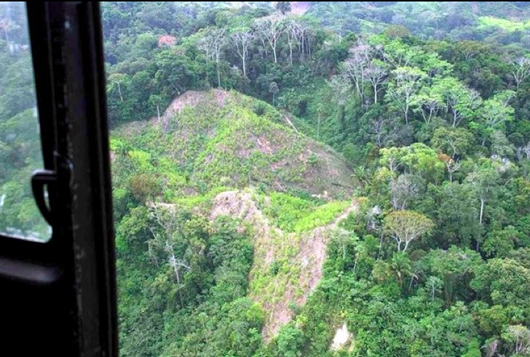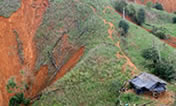cont...
The Dirty Dozen
Another nasty side-effect is the contamination of water sources through the dumping of harmful chemicals, fertilisers and pesticides – commonly called the Dirty Dozen - that are used for the production in the coca laboratories deep in the jungle. Among these are chemicals banned in industrialised countries, such as lindane or DDT. These chemicals can move over long distances through multiple cycles of condensation and evaporation called the ‘grasshopper effect’. Additionally the movement of people in these areas, in some cases protected areas such as National Parks, can deeply undermine animal and plant life.

Coca crops cause disastrous damage to fragile ecosystems such as the Andean forest and the plains and jungles of Orinoco and Amazon, but the problems aren’t isolated. In recent years coca crops have moved to the Choco-Darien area which is recognised as a biodiversity hotspot, where it is destabilising the ecological balance.
Despite being called the Dirty Dozen up to 32 known harmful chemical precursors including highlights of potassium permanganate, sodium hydroxide, ammonia, sulphuric and hydrochloric acid, acetone, methyl ethyl acetate are used in the process. To re-use these chemicals, coca laboratories use a distillation process. The result is a discharge into the rivers of thousands of litres of hot water, leading to changes in temperature that can damage aquatic ecosystems: according to studies the production of one kg of coca base produces 600 kg of waste and 200 litres of contaminated water.
This production pollution is compounded by methods used to eradicate the coca plants from the landscape. Planes sent by the US government indiscriminately spray the forest with herbicides, such as glyphosate. This may result in short term victories over some coca crops, but is not without side-effects. As well as the immediate loss of natural capital it forces the growers deeper into the fragile forest systems, destroying yet more biodiversity in its wake.
The future?
The aim of this campaign is to overcome the distinction between producers and consumers and to work together to overcome a problem that is causing dramatic problems in both the producing and consuming countries.
The largest number of consumers are still in the US and Europe. At least 12 million Europeans, 3.6% of the adult population have tried the drug, according to the European Monitoring Centre for Drugs and Drug Addiction (EMCDDA). For this reason the campaign has acquired an importance and relevance within several European countries.
Consumption is expanding throughout Europe, but particularly in Spain and the UK. The ever adaptable drug traffickers, aware of the profitability of this market in Europe and the US, are changing their routes to fit. Mexico and, especially, politically fragile West African countries are now the main targets for the drug cartels, but no suitable country is safe from this eminently exportable and profitable problem.
This ecocide is little known in Europe or the United States, so through the work of Shared Responsibility young people who are concerned about the fate of the planet can make more informed choices before they start using drugs.
Page 1 >
Page 2
Related links:
Get in touch with Oscar Cuervo about this article to find out more about the work they are doing to raise awareness of the problems, and possible solutions, to cocaine production in Colombia.
For regular news about Colombian conservation initiatives follow the NGO Pro Aves.
Colombia: Counting the cost of cocaine
16.04.10
 From ancient medicines, religious rituals, to famous soft drinks, and being sniffed off toilet-seats in high society clubs, very few plants have had such an effect on people and the environment as Erythroxylum coca (coca).
From ancient medicines, religious rituals, to famous soft drinks, and being sniffed off toilet-seats in high society clubs, very few plants have had such an effect on people and the environment as Erythroxylum coca (coca).
Ecuador: Yasuni - the most biodiverse place on Earth?
22.01.10
A study published in the open access journal Plos One has revealed extraordinary species richness in the western Amazon covering eastern Ecuador and northern Peru.
Philippines: Geo-tagging reveals mining threats on the “Last frontier”
01.02.10
 Plant Talk invited Dario Novellino from the Centre for Biocultural Diversity (CBCD), UK to speak out against the logging and mining in protected areas that is destroying the forests of Palawan.
Plant Talk invited Dario Novellino from the Centre for Biocultural Diversity (CBCD), UK to speak out against the logging and mining in protected areas that is destroying the forests of Palawan.